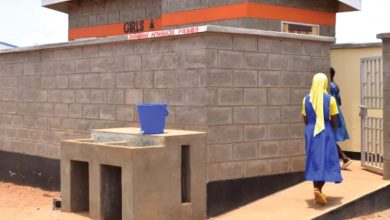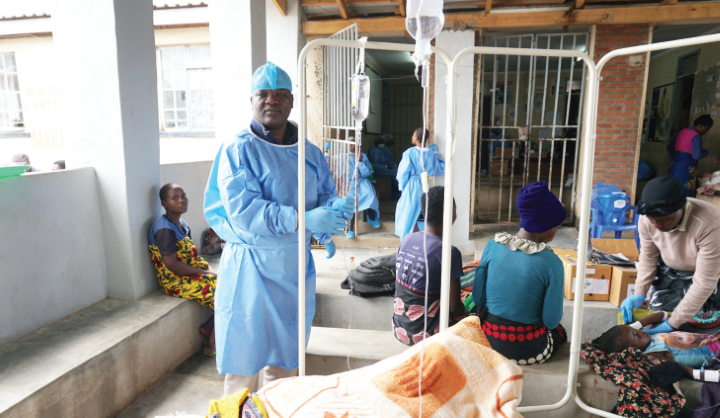Displaced children face malnutrition
March 10 was an extraordinary day for Dona Peter, who was six-month pregnant when she fled severe floods caused by Tropical Storm Ana in Mozambique.
“I was happy when I safely delivered a bouncing baby girl, named Steveria, while living in a congested camp. When I escaped the floods by boat, I had her well-being at heart,” she says, taking lunch in a crowded shade where the majority gave her a starved gaze.

However, the mother of three is terrified that the newborn may end up famished and frail like many malnourished children around her due to food scarcity.
The setting is Bangula Admarc, the largest camp for people displaced by Tropical Storm Ana in Malawi. Most families have nothing to cook or eat.
“This is my first meal in two days. My children and I can’t afford two meals a day. We live hand-to-mouth here. I do piecework and sell thorny firewood to buy flour and some fish so that my children won’t starve,” she explains.
The rising food scarcity fuels malnutrition among 125 children and 123 pregnant women in the displaced population of 9 000, down from 14 525 in January when tragedy struck.
The camp in grain sheds plays home to nutrition screening for children aged below five. Twice a week, Blamu Makawi, one of 16 health surveillance assistants at Kalemba Catholic Hospital in the vicinity, measures children’s body sizes and weight under a tree shade.
For him, the screening sessions held every Tuesday and Thursday morning are vital as children in emergency situations risk being left behind in efforts to end hunger and malnutrition.
“Frequent flooding and displacement increase exposure to child malnutrition, which is common at this camp. So far, eight children are severely malnourished and 99 have moderate malnutrition,” he explains.
Of the eight with severe acute malnutrition, three with complications were admitted to a nutrition rehabilitation programme where they received in-patient care for stabilisation of medication complications. The remainder got ready-to-use therapeutic food as outpatients.
“Malnutrition is rampant here because we lost everything, including food baskets and crops. We cannot afford all six main food groups. Food aid remains scanty and many children seldom get diversified diets because most donations include maize, flour and rice, which have low nutrients except energy-giving carbohydrates,” says Angelina Raphael, 44.
The mother of four, from Mlolo District in Mozambique, suffered the pain of seeing her two-and-a-half-year-old son wasting because of food scarcity in the camp.
“I take my two under-five children for nutrition screening because I don’t want to wake up to the news that the youngest, aged 13 months, is wasting as did Nyamazao,” she says.
Angelina says the boy was malnourished, sickly, weak and low-weight due to severe malnutrition.
This left the boy also having oedema, a build-up of fluids that causes swellings on the legs and arms
“He was so weak that he couldn’t sit down, eat or smile,” Angellina recalls
Makawi measured the circumference of the child’s arm midway between the shoulder and elbow.
“It was just about 11 centimetres and Nyamazao was admitted to Klemba nutrition rehabilitation at Kalemba,” he explains. “The mid-upper arm circumference of a healthy child measures at least 12.5cm.”
Nyamazao stabilised after a week of receiving F75 milk at the NRU. He later received rations of F100 milk and ready-to-use therapeutic food as an outpatient.
“Without the nutrition assessment in the camp, I wouldn’t have known that the boy had severe malnutrition and he would have died because he was sickly,” says Angelina.
Malnutrition retards children’s physical and mental growth as well as their health.
Unicef, with support from USAid and KFW, has reached over 3 302 children with severe acute malnutrition in the six districts most affected by floods.
Unicef in collaboration with World Food Programme, the Hunger Project and Story Workshop has supported the Ministry of Health and district councils to screen over 252 995 children and refer those with acute malnutrition for appropriate management at the nearest health facilities.
Nutrition screening in camps revealed an increasing count of children admitted for severe acute malnutrition treatment mainly in Chikwawa, Nsanje, Balaka, Chiradzulu and Phalombe districts in March compared to the same month last year.
The greatest increase was noted in Chikwawa, with an over 64 percent increase in such admissions from 526 in March 2021 to 867 this year.





